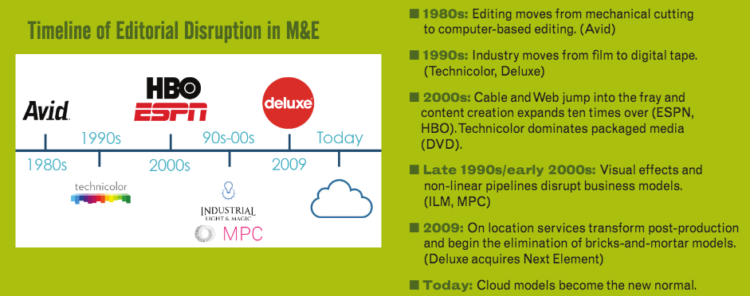Exclusives

M&E Journal: M&E’s Cloud Evolution and Revolution
Story Highlights
By David Benson, Founder, DSB Consulting –
Hollywood is no stranger to innovation. One hundred twenty years ago the first moving pictures left audiences awestruck, and in some cases running for the exits in a panic. Since then we’ve enjoyed the addition of sound, color, and special effects; the rise of radio, television, and cable; VCRs, DVRs, and On Demand; shifts from SD to HD and from 2K to 4K; and countless new behind-the-camera technologies that made us work smarter and what we produced better. But today M&E is in the early stages of one of the most challenging – and vital – evolutions in its history: The cloud.
One of the biggest misunderstandings about the cloud is that it’s some shiny new object. Movement toward the cloud was underway long before anyone heard the term “cloud.” Enterprises have been using “private clouds” pioneered by companies like VMWare and Citrix for a long time, but they were called “data center visualization.” Hotmail, a cloudbased email service, launched twenty years ago and was followed by Yahoo and Gmail. We’ve all been using cloud solutions every day for decades, but the average consumer didn’t realize it.
That’s one of the factors that make the cloud seem mystifying and scary. But conceptually it isn’t something the M&E industry hasn’t experienced before. Take the evolution from tube, to record, to cassette, to CD, to MP3. Each step was incremental until the quantum shift from a physical medium to digital. That was a gigantic leap that completely changed how we produce, deliver and consume music. It opened the door for radically new business models and innovation. The same thing is happening with the cloud. Companies like AWS have commoditized the virtualized data center infrastructure and offer it to the masses.
Endless innovation has continually disrupted and transformed M&E in previously inconceivable ways. Imagine telling someone in 1990 that Apple would become the world’s largest music retailer. Similarly, it wasn’t that long ago that very few people could envision a Netflix or Amazon utterly and completely transforming television.
But now we’re in a world where “binge watching” is a not only a thing, it’s a thing everyone enjoys. Streaming services are producing shows that win Emmys, cable networks are going a la carte, and TV production schedules and workflows are drastically, indelibly altered.
M&E pain points
* Film, television, music, news, sports, live events, advertising, video games – any company with digital assets – each face their own unique challenges that need to be addressed when it comes to the cloud. But there are some issues that broadly apply to the industry as a whole.
* Security is a prime concern, but downward pressure on budgets make it a luxury most companies struggle to afford.
* Cable, broadcast and streaming sites require new approaches to content production and distribution. For studios like Amazon and Netflix, cloud delivery is their default operating mode, putting all others at a disadvantage while they adapt.
* Modern studios and networks have moved away from capital expenditure investments on the balance sheet. Modular and on-demand cloud models have become ideal for streamlining and aligning business expenditures more directly to the productions that incur them.
* Tax and labor efficiency will continue to be major drivers of production and postproduction business decisions. Cloud allows deployment anytime, anywhere, on a moment’s notice.
While all of these are key factors driving adoption and evolution, the specter of security cannot be overestimated. The 2014 Sony hack was a seismic event that had an unprecedented impact on the industry and created an extreme awareness of security and liability.
There have been numerous other sophisticated corporate hacks of large companies, including Saudi Aramco, eBay, Target, JPMorgan Chase, Home Depot, and Anthem/Premera Blue Cross. But the Sony hack showed Hollywood what kind of pervasive, deeply rooted and widespread damage could be done to one of its own. Suddenly everyone in the industry was reevaluating everything they thought about the cloud, and it made all companies in the media space reconsider how they managed risk internally and where the cloud fit into their overall IT strategies.
Same ball, different game
Managing the cloud is fundamentally different from how you would manage a data center. Storage is very different. The way storage acts is different. Transfer between cloud services or even moving content within one provider, such as AWS data centers in Oregon and in Europe, is different. This has a monumental impact on day-to-day operations and requires a completely different way of thinking.

The cloud is a new paradigm that flips data center methodology on its ear. We used to mold solutions to fit the problems; now we have to mold problems to fit the available solutions.
In the past we focused on building one box that was insanely efficient and could do the work of five servers. Now the path to an amazing user experience has shifted. Disposable cloud infrastructure that can be spun up or down as users demand it is replacing complex formulas to predict when those same consumers would create the most load on a system. We need ten boxes that can do 50 percent less, so if two of them go down the user experience doesn’t change.
Facebook, for example, is a company that ships new software twice a day to a billion people. Doing that is difficult, and doing it elegantly is extremely difficult. In addition, there are many companies, including those that play in the M&E arena, that are experiencing a violent shove to their business models. “Product-focused” is being forced into “servicebased.” That’s the nature of the beast now, and overcoming the hurdles this presents can be daunting.
Once a cloud strategy is deployed it will need to be managed, maintained and grown. To be successful, this will require a totally different type of organization – and not just on the IT side. Companies need to apply a top-to-bottom rethinking of their thought processes, planning processes, and how goals are measured, executed and evaluated.
Holistic approach to the cloud
We’ve reached the philosophical tipping point where M&E is finally embracing the cloud because the benefits outweigh the fears. But recognizing “we have to do this” does not equal “we know how to do this.”
It’s never easy for companies to undertake a challenge that is outside their scope and focus, or for which they don’t have in-house expertise. Thankfully, there is a robust and growing spectrum of businesses that specialize in cloud technology. What is critical, however, is to also understand the myriad ways the cloud can and will impact M&E specifically.
Moving from one platform to another is more than just a technical, nuts and bolts exercise. Operations, finance, and workflow are all impacted by a shift to a cloud environment as well. If you look at a problem from a purely tech or purely media standpoint it won’t be obvious what the obstacles are – or will be – for any given solution. A comprehensive, holistic approach is what will lead to a successful, fully realized cloud strategy.
And it’s in that regard that Hollywood’s creative thinking and long history of innovation will need to influence not only its own evolution, but the cloud’s as well.
Click here to translate this article
Click here to download the complete .PDF version of this article
Click here to download the entire Spring 2016 M&E Journal









